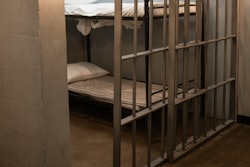When the coronavirus started to spread, Deborah Meehan, director of the University of Maine at Augusta Rockland Center, faced a dilemma – how to continue educating incarcerated students as prisons shut down and colleges moved online.
 Margaret diZerega,
Margaret diZerega,The center offers postsecondary education programs at five correctional facilities in the state, sending faculty to teach in-person classes. But when Maine’s prisons closed to outsiders, educators and corrections officers joined together to figure out what distance learning in prison could look like.
“We met with faculty, met with education coordinators inside the facilities, wardens and deputy wardens – everyone we could – to try to brainstorm [about] how are we going to do this?” Meehan said.
The prisons arranged Zoom classes where small cohorts could meet with their professors – they even held a debate class – though it took some “pretty exceptional” adjustments. Maximum security prisons, for example, typically don’t have internet access for inmates.
“We were running long Ethernet cables down hallways, through laundry rooms, into classrooms to make this work,” she said. “And we continued that through the semester.”
Like the rest of the higher education landscape, college programs in prisons across the country have had to rethink how they teach their students in the midst of the coronavirus. While some facilities still allow educators in as essential staff, many are temporarily pivoting to remote learning for students’ safety, despite “variable” access to technology, said Margaret diZerega, acting director of the Center on Sentencing and Corrections at the Vera Institute of Justice.
 Dr. Monique O. Ositelu
Dr. Monique O. OsiteluGetting study materials to students, let alone teaching classes, has required some creativity. Some schools are dropping off physical copies of readings and assignments until they figure out how to offer classes, while others have gotten permission for faculty to use the email systems incarcerated people use to contact their families. For classes, programs have come up with a range of solutions, from gathering incarcerated students in small groups for live Zoom classes or videos to giving them laptops and tablets with learning management systems installed.
“What a lot of folks are doing right now is assessing what technology does the prison have?” diZerega said. “Some of it is going to be needed for telemedicine or parole board hearings or other things that are kind of necessary operations…” Meanwhile, correctional facilities are also “revisiting some policies on limits to technology and [asking] how can they take whatever technology is available and make it work right now.”
While difficult, colleges learning how to better deliver online education to incarcerated students may benefit from these programs in the long run, said Dr. Monique O. Ositelu, a senior policy analyst with the education policy program at the think tank New America. She described the pandemic’s impact on prison education as “unfortunate” but “fertile ground for innovation.”
Going forward, universities might be more prepared to offer incarcerated students hybrid programs that use both in-person instruction and online tools, she said, which would be particularly helpful for prisons in “higher education deserts,” where instructors often need to drive from several hours away. It could also allow more options for less expensive courses.
Right now, technology is “continuing education but also opening access,” she said, and specifically at a time when postsecondary educational opportunities are already growing for people in prison.
Late in April, the Department of Education announced that it would expand the Second Chance Pell Experimental Sites Initiative, more than doubling the program by allowing another 67 colleges to offer need-based Pell Grants for incarcerated students to pursue higher education.
 Deborah Meehan
Deborah Meehan“I’ve had the pleasure of visiting several Second Chance Pell institutions and have seen firsthand the transformative impact this experiment has on the lives of individuals who are incarcerated,” noted Secretary of Education Betsy DeVos in a statement. “By expanding this experiment, we are providing a meaningful opportunity for more students to set themselves up for future success in the workforce. The stories I’ve heard from students and institutions engaged in the experiment are very encouraging, and we look forward to seeing how this expansion will help even more students achieve a better future.”
To diZerega, the decision shows the extent of bipartisan support for these students, that “even in the midst of a crisis like this, that momentum is carried forward.”
In the meantime, existing programs are determined to continue serving incarcerated students as lockdowns continue. The University of Maine at Augusta Rockland Center is planning for summer classes, though the term will be shorter and start later than usual to minimize students’ stress.
Even though there are no COVID-19 cases in Maine correctional facilities yet, “there’s a lot of anxiety in prisons right now, given the virus and how vulnerable that population is,” she said. “They’re worried about getting sick, about being in proximity to people who are sick.”
Her advice to other prison education programs fielding the crisis is to build up “relationships of trust” with the local department of corrections, because educators can’t implement online programs without collaboration from inside these facilities. She also stressed the importance of keeping in close communication with students, offering frequent updates so that they don’t feel abandoned.
“This is a really important part of their identities, of their lives, of their mental health to be in the college program…” Meehan said. “I think those personal touches were really important to let the students know we weren’t just going to throw our hands in the air and say, ‘Forget it. We’re not going to do this anymore. It’s too hard.’ It was hard. But it was so well worth it.”
Sara Weissman can be reached at [email protected].



















